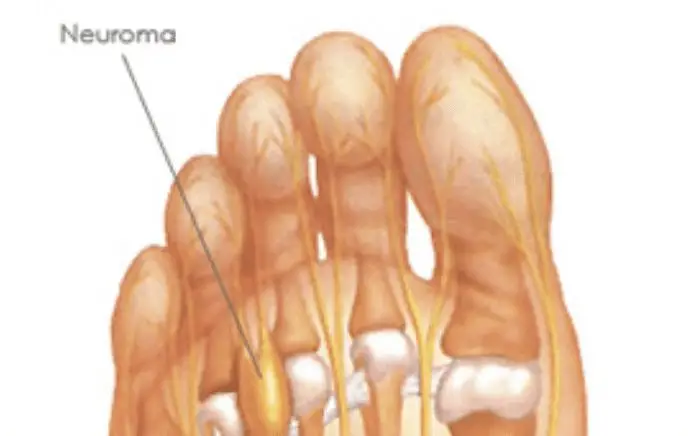MORTON’s NEUROMA
What is a Neuroma?
A neuroma — often referred to as a pinched nerve, nerve tumor, or Morton’s neuroma — is a benign thickening of nerve tissue, most commonly located between the third and fourth toes. It can cause sharp, burning pain in the ball of the foot, along with tingling, numbness, or the sensation of “walking on a pebble.”
At SoCal Foot and Ankle Doctors, with locations in Santa Monica and the Cedars-Sinai Medical Towers, we offer advanced diagnostics and treatment options for neuromas, helping patients return to pain-free activity without surgery whenever possible.

What Causes a Neuroma?
Neuromas are caused by chronic compression or irritation of a nerve, usually due to foot mechanics or footwear that compress the metatarsal heads.
Common Contributing Factors:
- Wearing tight or narrow shoes (especially high heels)
- Flat feet or high arches
- Repetitive stress or impact activities (running, sports)
- Foot deformities, such as bunions or hammertoes
- Prior trauma to the forefoot
Over time, this pressure causes the nerve to swell and thicken, leading to inflammation and pain.
Neuroma Symptoms
- Sharp, burning pain in the ball of the foot
- Tingling or numbness between the toes
- Feeling like there’s a rock or fold in your sock
- Worsening pain with tight shoes or prolonged walking
- Relief when removing shoes and massaging the foot
Most commonly affects women aged 30–60 and is often linked to footwear choices and foot structure.
Diagnosis of Morton’s Neuroma
Diagnosis is typically based on:
- Clinical evaluation
- Palpation between metatarsals to elicit pain or click (Mulder’s sign)
- Ultrasound to visualize nerve thickening
- MRI for complex or chronic cases
Neuroma Treatment in Santa Monica & Cedars-Sinai
At SoCal Foot and Ankle Doctors, we prioritize non-surgical care to relieve symptoms and prevent progression.
Conservative Treatments:
- Shoe modification – wearing wide-toe box shoes with cushioning
- Custom orthotics to offload pressure from the metatarsals
- Padding to reduce nerve irritation
- Anti-inflammatory medications
- Steroid injections to reduce swelling and nerve inflammation
Advanced Therapies:
We offer minimally invasive and regenerative options to avoid surgery:
- Alcohol sclerosing injections – a series of injections to chemically shrink the neuroma
- Radiofrequency ablation (RFA) – targeted nerve modulation to reduce pain
- Platelet-Rich Plasma (PRP) – to address inflammation and surrounding soft tissue damage
- Amniotic or fetal tissue allografts – in select chronic or recurrent neuroma cases
Surgical Treatment (If Needed)
When conservative and advanced therapies fail, surgical excision of the neuroma may be performed on an outpatient basis. Most patients walk the same day with postoperative shoe gear and resume normal activities in a few weeks.
Don’t Ignore Nerve Pain in Your Foot
If you’re experiencing persistent burning, tingling, or sharp pain in the ball of your foot, don’t wait. Early treatment can prevent permanent nerve damage and the need for surgery.
Schedule a consultation at SoCal Foot and Ankle Doctors in Santa Monica or the Cedars-Sinai Medical Towers to explore your options for fast and lasting relief.
Our Docters
Our Board Certified Podiatrists
Socal Foot and Ankle doctors are committed to delivering the most exceptional treatments.

Board Certified Foot & Ankle Specialist
Office Time
Location: Santa Monica
Mon – Thur: 9:00 AM – 5:00 PM
Friday: 9:00 AM – 5:00 PM

Board Certified Foot & Ankle Specialist
Office Time
Location: Santa Monica
Mon – Thur: 9:00 AM – 5:00 PM
Friday: 9:00 AM – 5:00 PM
Request Appointment
NON-INVASIVE ADVANCED TREATMENT
BOARD CERTIFIED
FOOT & ANKLE
Surgeons
Years Experience
Happy Patients
Location
Local Partners
